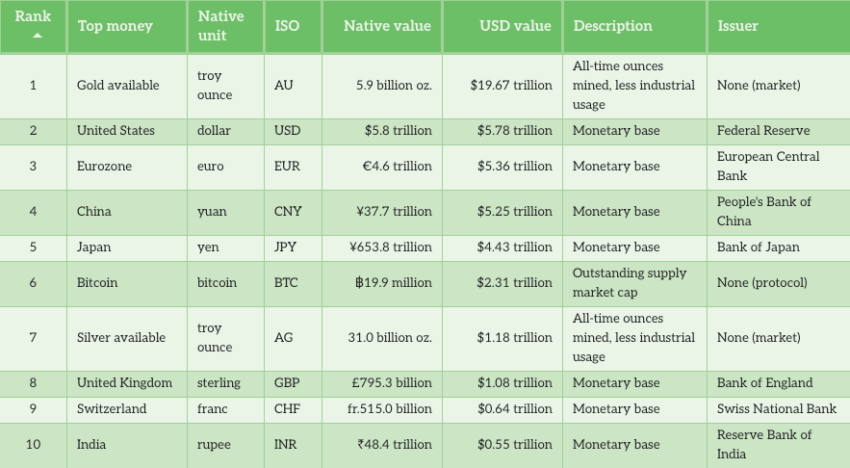The cryptocurrency market faces a critical juncture as the People’s Bank of China (PBOC) considers stimulus measures in response to slowing economic activity.
Analysts suggest that if Beijing injects liquidity into the system, altcoins could experience a significant rally, potentially surpassing previous all-time highs.
China Stimulus Possible in Next Month
While headlines often focus on the US Federal Reserve, China’s monetary policy exerts an equally crucial influence on global risk assets, including cryptocurrencies. A March 2025 21Shares report highlighted a 94% correlation between Bitcoin’s price and global liquidity, surpassing the S&P 500 and gold. This correlation underscores the significance of central bank policies in shaping investor sentiment toward crypto markets.
According to Porkopolis Economics, the U.S. M0 monetary base currently stands at $5.8 trillion, followed by $5.4 trillion in the eurozone, $5.2 trillion in China, and $4.4 trillion in Japan. Given that China accounts for nearly 19.5% of global GDP, the PBOC’s policy decisions carry weighty implications for international capital flows, even when the Fed dominates market attention.
China’s economic data in July 2025 highlighted several areas of weakness. Retail sales fell 0.1% month-on-month, while fixed-asset investment declined 5.3% year-on-year, the steepest contraction since March 2020, according to estimates from Goldman Sachs. Industrial production, meanwhile, inched up 0.4%, indicating limited growth momentum.
Unemployment also showed signs of stress, with the survey-based urban jobless rate climbing to 5.2% in July, up from 5.0% in June. Bloomberg noted that the PBOC could introduce stimulus measures “as soon as September,” while economists at Nomura and Commerzbank echoed the expectation of imminent support policies.
Central banks typically deploy stimulus through interest rate cuts or special financing conditions, effectively expanding the money supply. Such interventions historically boost risk assets, including stocks and cryptocurrencies, by making liquidity more accessible and reducing financing costs. In the crypto context, this could translate into renewed demand for altcoins, which have historically been sensitive to shifts in global liquidity.
US Market Signals Provide Context
Despite growing fears of a recession in the United States, markets have remained remarkably resilient. The University of Michigan’s consumer survey, released in early August, revealed that 60% of Americans expect unemployment to worsen over the next year, a sentiment last recorded during the 2008–09 financial crisis.
Yet, investors continue to display optimism. The S&P 500 closed above 6,400 for the first time ever, while 5-year U.S. Treasury yields rebounded from 3.74% on August 4 to 3.83% on Friday, signaling reduced risk aversion. Higher Treasury yields often indicate a willingness among investors to embrace riskier assets, as demand for government-backed instruments diminishes when confidence improves.

For the cryptocurrency market, this combination of factors—resilient equities, rebounding yields, and potential Chinese stimulus—creates a fertile environment for altcoin recovery. Should the PBOC follow through with expansionary measures, the influx of liquidity may catalyze a broad rotation into cryptocurrencies, driving prices higher across a range of tokens.
Altcoins: Navigating the Uncertainties
Before the 2017 crackdown, China was one of the world’s largest markets for crypto and altcoins, with significant grassroots and institutional interest. Altcoins like NEO and VeChain, which have strong Chinese roots, were especially popular among local investors.
Although China’s crypto ownership rate has dropped to about 5.2%, reflecting declining retail participation due to government restrictions, Chinese blockchain projects and altcoins continue to have strong enterprise and technical support, and many Chinese citizens reportedly engage in crypto markets via offshore platforms or proxies despite restrictions.
Despite favorable liquidity conditions, several uncertainties remain. Global recession fears, geopolitical tensions, and evolving regulatory frameworks could temper investor enthusiasm. Moreover, while China’s stimulus may inject liquidity, the effectiveness of such measures will depend on market perception and execution. If stimulus policies are insufficient or temporary, the altcoin market may respond only modestly.
Analysts also emphasize the importance of US economic conditions. Rising Treasury yields indicate that investors are increasingly pricing inflation and growth expectations. These signals interact with Chinese liquidity policies, creating a complex backdrop in which altcoins may flourish or experience headwinds. Investors should also monitor the Trump administration’s China tariffs, which have been delayed for another 90 days.
The post China Stimulus Could Spark Altcoin Rally as Economic Data Weakens appeared first on BeInCrypto.
